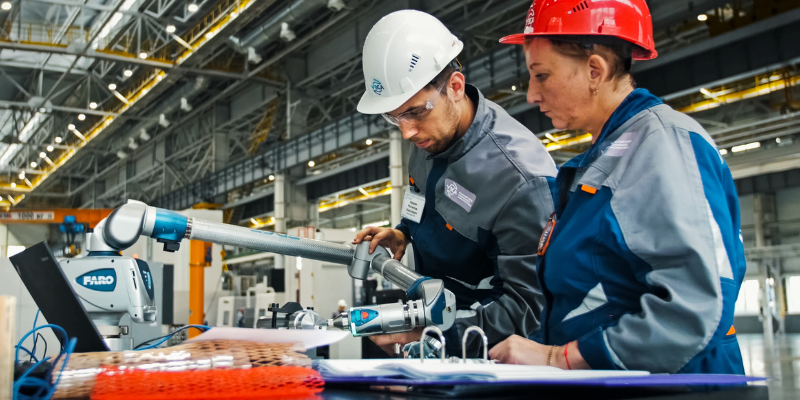
Training
5 min read
Knowledge vs. Skills: Why Manufacturers Must Train For Both

Two terms manufacturing leaders use a lot are knowledge and skills.
You’ve probably read material and even participated in training programs around topics like tribal knowledge, solving the skills gap, employee upskilling, and knowledge management.
Dozuki is passionate about both. We’ve dedicated a dozen years to helping manufacturing leaders develop competence and versatility across their frontline workforce.
Here, we’ll break down the difference between knowledge and skills, how to assess them within your workforce, and how to use both for true frontline versatility.
What’s the Difference Between Knowledge and Skills?
Knowledge is the awareness or familiarity gained by experience. It refers to theoretical information about a given topic, and is the foundation for acquiring and mastering skills.
If your frontline worker knows how a bearing works, they possess knowledge.
But knowledge is more than simply memorizing information. In manufacturing, knowledge consists of three components:
- The What: What is it? What can I do with it?
- The How: How does it work? How can I do the process?
- The Why: Why is this important? Why do we do it this way?
Skill is the ability to do something effectively. Skills are the application of knowledge combined with the use of the senses.
If your frontline worker knows how to clean, inspect, and repack a bearing. And they can consistently perform that in ten minutes with near perfect quality, they possess a skill.
But skills exist on a spectrum. Here are the three ways manufacturing companies determine employee skill level:
- Adherence to the process steps, including safety & ergonomics
- Consistently working within the standard cycle time
- Consistently achieving the expected quality standard
How Can Manufacturers Assess the Knowledge and Skills of Their Workforce?
Since knowledge is informational, it can be assessed using a variety of methods. From quizzes to discussions to drawings to games, there are numerous ways to see how familiar people are with certain processes.
Training programs are ideal for assessing knowledge, as there are many topics that operators need to be trained on that don’t directly result in the gain of a skill.
Evaluating skills, however, requires a trainer or supervisor to observe the trainee completing a task or process with some kind of assessment. These assessments should be built to evaluate adherence to the process, quality standards, and time spent.
Once the training assessment is complete, then other factors can be used to create a weighted skill level calculation. This allows for each operation to evaluate the skills of their frontline based on the metrics that matter most to them (e.g. quality adherence, safety adherence, number of completions within cycle time, etc.)
What Are the Potential Obstacles of Determining Workforce Skill Levels?
The factors that determine skill level are not absolute. They can’t be completely derived from data. There are factors that need to be evaluated using judgment and experience.
As an example, one person can’t look at the distance their friend drives a golf ball, and determine how good their swing is.
In manufacturing, repetitions (the number of times an operator has completed a task) can be a misleading, even dangerous indicator of skill level. Without consideration of other variables like cycle time, takt time, quality, safety, and ergonomics, using repetitions to determine skill level only tells you one thing: The person completed the task and lived to tell about it.
Using repetitions to determine skill level perpetuates the pencil whipping culture that exists in the manufacturing industry, where teams have documentation without actually knowing or reviewing what it is that is being approved.
Here’s a use case from one of our customers, a global flooring company. They calculated that someone accidentally setting up a key machine wrong was costing the company $7,500 dollars a month — or $90,000 a year. After implementing Dozuki, that cost was cut by 10% and was able to save $18,000 in scrap reduction over two years.
Use cases like these are a warning. Time to level up your frontline training.
If you want to grow your knowledge base and upskill employees, here are our recommendations:
- Utilize connected worker solutions that offer at-a-glance visibility into the current training status of your frontline workers across lines, shifts and locations.
- Automate the triggers for retraining based on scheduled time recurrence, or whenever standards are updated.
- Review competency of workers nearing retirement and employ upskilling paths for replacements to stay ahead of the curve.
Now that you understand the distinction between knowledge and skills (and how to assess them accordingly) you can empower workers to be the best version of themselves, while still hitting production targets.
Interested in learning more about how Dozuki helps companies advance the skills of their frontline? Come talk to us.
Topic(s):
Training
Close the Skills Gap
Dozuki is purpose-built to support the operational training of your workforce in any manufacturing environment.
Related Posts
View All Posts
Training
Why Workforce Agility Is Your Most Strategic Investment
4 min read
In times of economic uncertainty, slow-moving companies lose. Whether it’s a pandemic, a supply chain breakdown, or a trade policy overhaul, one thing is clear: if your...
Continue ReadingHow Blue Buffalo Scaled Expert Training with Dozuki
5 min read
When the team at Blue Buffalo set out to transform how they trained their operators, they weren’t just looking for a software tool, they were looking for a smarter way to...
Continue ReadingHow General Mills Cut Training Time by 62% Using Dozuki
8 min read
What does it take to streamline training in a fast-paced, high-turnover manufacturing environment? For General Mills, the answer was clear: transform outdated systems into a...
Continue Reading



